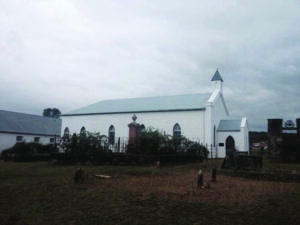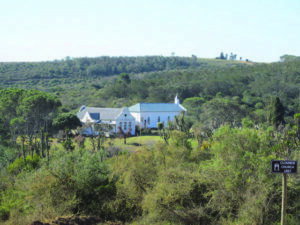The history of Clumber Church, Part 1
Clumber Church, outside Bathurst on the Shaw Park road celebrates its 150th anniversary this year. The main celebrations, which also coincide with the renovations to the church, take place from 20 to 22 October. Courteney George Bradfield, a descendant of one of the early settlers for whom the church was a refuge, tells its history. This week we publish the first instalment: ‘Hard times, desperate measures’.

In the vale of Clumber in the Eastern Cape, 5km from Bathurst just off the Shaw Park road, lies Clumber Church. Situated on a knoll, this is the third Church to be built on this spot by the Nottingham Party and descendants of the 1820 Settlers.
This knoll was given the name of Mount Mercy by the Nottingham Party in thanksgiving for their safe arrival here on a journey which had taken them over six months to complete. The wagons and carts that had transported them from “Tent Town” on the dunes of Algoa Bay to their final destination were offloaded at the base of Mount Mercy close to the Torrens River. A Service of Thanksgiving was held on Mount Mercy on the day of their arrival on 23 July 1820.

The Nottingham Party was one of the few parties of 1820 Settlers that comprised the poor, as Nottingham was a cottage industry hub of lace and hosiery making. With the Industrial Revolution under way, most of these family run cottage industries had to shut down.
It was also a time of the end of the Napoleonic Wars, so demand for goods had slackened off and soldiers had returned from war with no prospect of employment. It was a time of massive unemployment, with thousands starving.
The move to Mount Mercy
The prospect of a piece of land in a foreign country in the face of that hardship seemed appealing and hundreds applied. As the applicants could not even afford the passage, the Duke of Newcastle agreed to garner financial support and raised sufficient funds to allow the 60 men, 26 women and 72 children to emigrate.
From records, we are able to determine that the departure was rather hurried. John Bradfield’s application was dated October and by mid-January the family was aboard the Albury in Liverpool.
The Party gathered in Nottingham from where the men walked over the Pennine Moors under Sergeant Dennison to Liverpool, while the women and children travelled by coach and cart. By 17 January, they were aboard the Albury. There had been a delay as they tried to reconcile the records of those who had applied versus those who were already aboard.
It was bitterly cold in England, with vessels on the Thames icebound. The plans to depart before the end of January were thwarted by a cold front which had swept in and delayed departure until 13 February. The Albury struck severe weather off the coast of Wales and the hatches had to be battened down, much to the consternation of those below. Conditions were cramped, with married couples lying four and even six to a bed. The single men were given a blanket and had to lie where they could on the bare boards.
On 1 May 1820 the Albury arrived in Simon’s Town but the Settlers were not able to disembark. Their cramped conditions were made even worse when three Parties from the vessel Zoroaster numbering 142 persons joined the Albury on their last leg to Algoa Bay.
They arrived here on 15 May, together with vessel Aurora, carrying 344 persons, vessel Brilliant carrying 144 and Weymouth carrying 478.
Here they had to ride at anchor and await their turn to be pulled to shore. Once disembarked, they were housed in tents on the sea shore awaiting their turn for the ox wagons and carts to take them onto their final destination. Some 2 000 tents provided accommodation for this massive influx of people. The Nottingham Party waited here for 48 days before finally leaving on 15 July 1820.
The convoy of wagons used the coastal route from Addo Heights, passing Congo’s Kraal and Graafwater, to Jager’s Drift on the Bushman’s River. After Theopolis Mission Station they forded the Kowie River near the mouth and turned inland to Bathurst and to their final destination, which they named Clumber after the seat of the Duke of Newcastle, Clumber Park.
- Courteney George Bradfield attended Clumber Church, Clumber Sunday School and Clumber School in his youth. A descendant of Granville Glasson Bradfield, father, Edmund George Bradfield, grandfather, Jonathan Bradfield, Great Grandfather, Joseph Bradfield, GG Grandfather and John Bradfield GGG Grandfather, all buried at Clumber. He is the current compiler of the church website and Chairman of the church committee.



